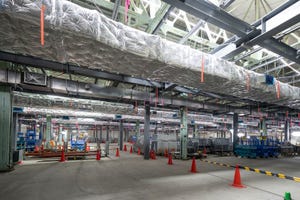A vaulted arch nanostructure helps improve the possibility of silicon anodes in lithium-ion batteries.
March 7, 2021
The push is on to find ways to increase the capacity and performance of lithium-ion batteries. Cell phones, personal electronics, electric vehicles (EV), and electrical power grids have all come to rely on battery technology. The commercially available configurations are reaching their limits, so new materials and technologies are being invented to increase energy storage capabilities.
The Limits of the Graphite Anode
One area of particular interest is the anode (the negative electrode). The anode stores lithium ions during charging and releases them when the battery is discharged. A lithium metal foil can be used for the anode. This provides an enormous amount of lithium ions during discharging, but during the charging process lithium metal unevenly plates onto the anode surface, creating spikey dendrite crystals that can short out the battery cell and cause a fire. Solid electrolytes made from polymers or ceramics are being studied to help suppress the dendrite growth but have not reached the point where they are widely available commercially.
Nearly all commercial lithium-ion batteries use an anode made from carbon graphite. During charging, the lithium ions are inserted between the layers of carbon atoms in a process called intercalation. During discharging, the lithium ions are released from the anode. But graphite anodes have limitations.
"When a battery is being charged, lithium ions are forced to move from one side of the battery—the cathode—through an electrolyte solution to the other side of the battery—the anode. Then, when a battery is being used, the lithium ions move back into the cathode and an electric current is released from the battery," explained Marta Haro, a former researcher at the Okinawa Institute of Science and Technology (OIST) in a press release from the institute.
"But in graphite anodes, six atoms of carbon are needed to store one lithium-ion, so the energy density of these batteries is low," Haro added.
Silicon Anodes
Research is underway to find materials that can increase the number of lithium ions stored in the anode and increase a lithium-ion battery’s energy density. One promising candidate is silicon, which can bind four lithium ions for every one silicon atom.
"Silicon anodes can store ten times as much charge in a given volume than graphite anodes—a whole order of magnitude higher in terms of energy density," said Haro. "The problem is, as the lithium ions move into the anode, the volume change is huge, up to around 400%, which causes the electrode to fracture and break."
This large change in volume during lithium-ion intercalation prevents the stable formation of a protective layer that usually forms between the electrolyte and the anode. Every time the battery is charged, this layer therefore must continually reform which uses up the supply of lithium ions and reduces the lifespan and rechargeability of the battery.
“Our goal was to try and create a more robust anode capable of resisting these stresses, that can absorb as much lithium as possible and ensure as many charge cycles as possible before deteriorating,” said Panagiotis Grammatikopoulos in the OIST release. “And the approach we took was to build a structure using nanoparticles.”
Layered Anode Structure
In prior research, the now-disbanded OIST Nanoparticles by Design Unit developed a layered cake-like anode structure, with each layer of silicon sandwiched between tantalum metal nanoparticles. This improved the structural integrity and helped to prevent swelling of the silicon anode. Experimenting with different thicknesses of the silicon layer gave an unexpected result.
“There was a point at a specific thickness of the silicon layer where the elastic properties of the structure completely changed,” said Theo Bouloumis, a Ph.D. student at OIST who conducted the experiment. “The material became gradually stiffer, but then quickly decreased in stiffness when the thickness of the silicon layer was further increased. We had some ideas, but at the time, we didn’t know the fundamental reason behind why this change occurred.”
Using microscopy and computer simulations at an atomic level, the OIST researchers determined that “…as the silicon atoms are deposited onto the layer of nanoparticles, they don’t form an even and uniform film. Instead, they form columns in the shape of inverted cones, growing wider and wider as more silicon atoms are deposited.” The individual silicon columns eventually touch each other, forming a vaulted structure. “The vaulted structure is strong, just like an arch is strong in civil engineering,” said Grammatikopoulos. “The same concept applies, just on a nanoscale.”
Value of the Vaulted Arch
The team also found that the increased strength of the structure coincided with enhanced battery performance. In electrochemical tests, they found that the lithium-ion battery had an increased charge capacity and that the protective layer was also more stable, meaning the battery could withstand more charge cycles.
According to the researchers, “These improvements are only seen at the precise moment that the columns touch. Before this moment occurs, the individual pillars are wobbly and so cannot provide structural integrity to the anode. And if silicon deposition continues after the columns touch, it creates a porous film with many voids, resulting in a weak, sponge-like behavior.”
Although the goal of the research was to improve silicon anodes for lithium-ion batteries, the vaulted structure may have other applications. “The vaulted structure could be used when materials are needed that are strong and able to withstand various stresses, such as for bio-implants or for storing hydrogen,” said Grammatikopoulos. “The exact type of material you need – stronger or softer, more flexible or less flexible – can be precisely made, simply by changing the thickness of the layer. That’s the beauty of nanostructures.”
Kevin Clemens is an engineering consultant who has worked on automotive and environmental projects for more than 40 years.
About the Author(s)
You May Also Like




